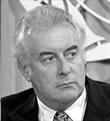PRIME MINISTER PRESS STATEMENT NO. 461
7 MARCH 1975
JOINT STATEMENT BY PRIME MINISTER AND TASMANIAN PREMIER
( Following their meeting in Canberra on Thursday night
6 March 1975)
The following joint statement was made by
the Australian Prime Minister, the Hon. E. G. Whitlam,
and the Premier of Tasmania, the Hon.
E. E. Reece, following a meeting in Parliament
House last night to discuss matters arising out of the
collapse of the Tasman Bridge in Hobart..
" The immediate problem arisir~ g from the
collapse of the Tasman Bridge is to restore as quickly
as possible means of communication between the
Eastern Shore and the main part of the city on the west
of the Derwent River, leaving questions of liability and
financial responsibility to be sorted out later.
This problem can be seen in two parts.
The first is to make temporary and shorterterm
arrangements to keep passenger and vehicular traffic
flowing between the two parts of the city. This task has
been tackled energetically by the State and Australian
Government agencies concerned. Further efforts in this
direction are receiving top priority and are being
intensified. The second and necessarily longer-term part of
the problem is to restore the original Bridge to a
satisfactory trafficable condition. This is a very big
task from an engineering point of view. It is, nevertheless,
the best way of restoring the position in the medium term.
The building of a second bridge of a permanent type at another
location will, in due course, make its contribution to
the increase of traffic between the two sides of the Derwent.
It must be appreciated, however, that the design and
building-of a second crossing will inevitably take longer
than will the repair of the existing Bridge. till, F
We have, therefore, concentrated our
immediate attention at this meeting on how to organise
the clearing of the river-bed in the near vicinity of
the Bridge, with the object of enabling the engineers to
decide finally how best to repair the existing structure
and support the new spans to bridge the present gap and
then to get the reconstruction job going.
To overcome the problems of divided control
and divided responsibility we have agreed to support
the establishment of a Special Joint Commission to
superintend and direct the combined salvage and rebuilding
operation. This will be done through an inter-governmental
Agreement, the mnain points of which we have already
accepted, and this Agreement will, in due course, be
submitted to the Australian and State Parliaments
for their approval. In the meantime we will proceed at once with
the nomination of the Commissioners, and will ask them
to act as an Interim Commission pending the creation
of the substantive body. They will commence their work
immediately upon appointment and will be given wide
powers of decision. The Chief Commissioner will be jointly appointed
by and be responsible to the Prime Minister and Premier.
One Associate Commissioner will be appointed by the
Australian Prime Minister and another by the Premier of
Tasmania. Each of the Commissioners will be highly
qualified in engineering and experienced in large-scale
construction projects. The Commission will have as its
Chief Executive Officer the Tasmanian Director of Public
Works and the Commission will be able to borrow or
recruit appropriate skilled staff as required.
We are happy to be able to announce that Sir
Allan Walton Knight, the Present Chairman of the
Tasmanian Hydro-Electric Commission, has accepted our
invitation to act as Chief Commissioner. Sir Allan is
Widely known throughout Tasmania, and indeed in engineering
circles throughout the world, as a great engineer and
administrator. The names of the two Assistant Commissioners
will shortly be announced, as will the details of the
proposed Agreement between the Australian and Tasmanian
Governments
We express our great admiration for the
work already done in trying to cope with this very difficult
situation by the numerous Commonwealth and State departments
and agencies concerned. Naturally a lot of this work is not
fully seen nor readily appreciated by those adversely
affected by the accident. Nevertheless, the efforts made
have been quite outstanding. Great credit is due to
all who have helped in the initial reaction to the disaster.
We emphasise that the salvage and engineering
problems involved in restoring the Bridge are most
severe. The sulken ship lies in very deep water, and the
river-bed is overlain by a thick layer of mud which no
diver can penetrate. Visability is extremely limited and
strong currents make the work difficult and hazardous.
Much of the visible debris and parts of the ship have to
be removed, and the area probed to locate any invisible
obstructions to new supporting structures, before the
final reconstruction plan can be determined and new supports
built. In the meantime, and with all possible speed,
preparatory work will go on while the underwater site
is being cleared." The Prime Minister and the Premier expressed
their appreciation of the efforts of Sir Roland Wilson,
who had assessed the situation on behalf of the
Prime Minister, conceived the notion of a Bridge Commission
and prepared the comprehensive agreement which was
signed today. Sir Roland, they said, would continue to
act as special adviser to the Prime Minister in respect
of the Tasman Bridge and would consider and advise on
all of the consequences of the bridge disaster.

